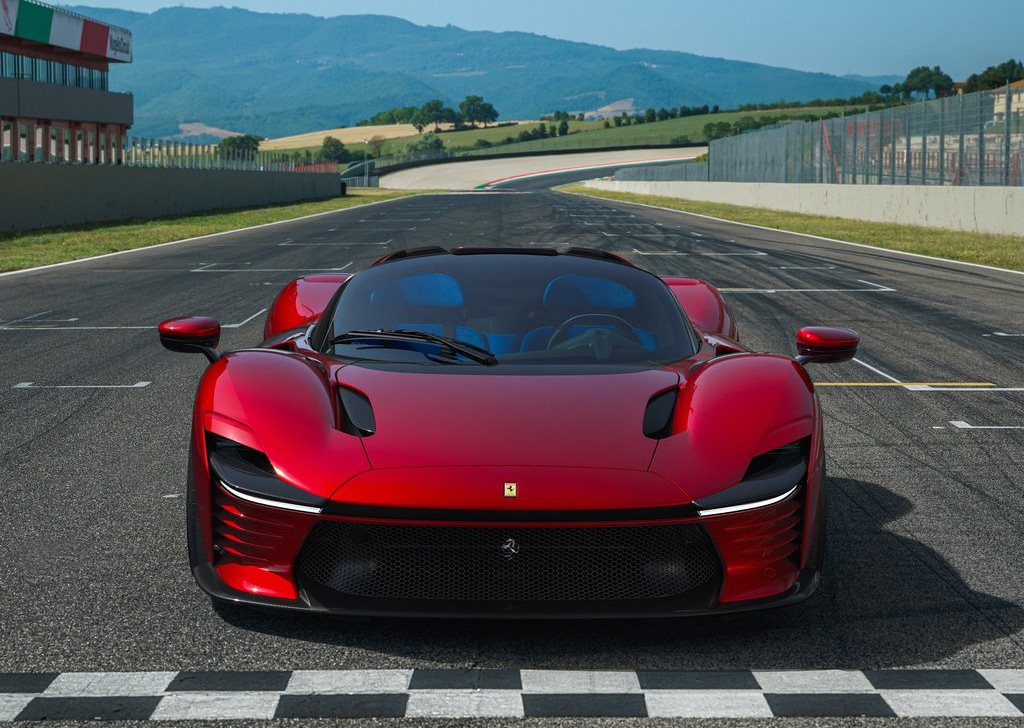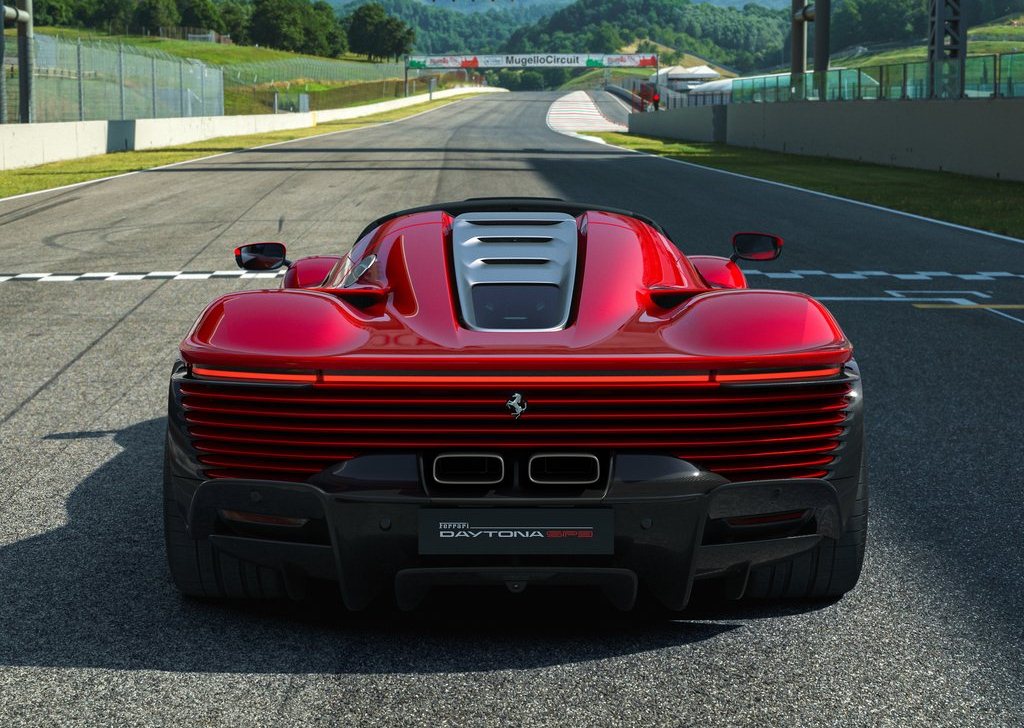The name of the new Icona evokes that legendary 1-2-3 finish and pays homage to the Ferrari sports prototypes that helped earn the marque its unparalleled motor sport status. The Ferrari Daytona SP3, presented at the Mugello Circuit during the 2021 Ferrari Finali Mondiali, is a limited edition that joins the Icona series which debuted in 2018 with the Ferrari Monza SP1 and SP2.
STYLING
Although inspired by the stylistic language of 1960s racing cars, the Daytona SP3 is clothed in very undeniably original, modern forms. Its sculptural power celebrates and interprets the sensual volumes of sports prototypes to wholly contemporary effect. It goes without saying that a design this ambitious demanded a meticulously planned and executed strategy from Chief Design Officer Flavio Manzoni and his Styling Centre team.
EXTERIOR
From the wraparound windscreen back, the Ferrari Daytona SP3's cabin looks like a dome set into a sensual sculpture with sinuous wings emerging boldly either side. The car's overall balance is underscored by monolithic volumes that are a powerful articulation of the long-appreciated skills of Italian coachbuilding at its finest. The fluidity of its masses melds effortlessly with sharper surfaces, to produce the sense of effortless aesthetic balance that has long been a signature of Maranello's design history.
The clean double-crested front wings are a nod to the sculptural elegance of past Ferrari sports prototypes of the likes of the 512 S, 712 Can-Am and 312 P. The shape of the wheelarches efficiently connotes the geometry of the flanks. At the front, they are structural and create a powerful link between wheel and well by not completely following the circular profile of the tyre. The rear flank swells out from the sylph-like waist giving rise to a powerful rear muscle that wraps around the front of the wheels, then tapers back towards the tail, lending a powerful dynamism to the three-quarter view.
Another key element is the butterfly doors, which have an air box integrated into them to channel air to the side-mounted radiators; the resulting sculptural forms give the doors a pronounced shoulder housing the air intake that is visually linked to the vertical cut of the windscreen. The pronounced surface of the doors, whose leading edge forms the rear of the front wheelarch, also helps to manage the airflow emerging from the front wheels. This surface treatment also closely recalls that of cars such as the 512 S which partly inspired the Daytona SP3's stylistic code.
INTERIOR
Even the Daytona SP3's cockpit takes its inspiration from historic Ferraris such as the 330 P3/4, the 312 P and the 350 Can-Am. Starting with an idea of a high-performance chassis, the designers crafted a meticulously refined space that delivers the comfort and sophistication of a modern Grand Tourer whilst keeping the styling language quite minimalist. It retains the philosophy behind certain styling codes: the dash, for instance, is minimalist and functional yet also entirely contemporary in feel. The typical upholstered cushions that were directly attached to the chassis on sports prototypes have been transformed into modern seats integrated into the body, creating a seamless textural continuity with the surrounding trim.
Several exterior elements, including the windscreen, positively influenced the interior architecture. Seen from the side, the cut of the windscreen header rail creates a vertical plane that divides the cockpit in two, separating the functional area of the dashboard that hosts the instrumentation from the seating. This architecture neatly executes the difficult feat of being both extremely sporty and very elegant at the same time.
The Daytona SP3's interior aims to guarantee both driver and passenger a snug driving environment by drawing on styling cues typical of competition cars. The main idea was to broaden the cabin visually by creating a clear break between the dash area and the two seats. The latter, in fact, are part of a seamless textural continuity, their trim extending all the way to the doors, reproducing the elegant functionality typical of sports prototypes. This same extension of the trim can also be seen on the sill area when the doors are open.
POWERTRAIN
To give the Daytona SP3 the most exhilarating V12 on the market, Ferrari chose the 812 Competizione's engine as its starting point, but relocated it to the mid-rear position to optimise the intake and exhaust layout as well as fluid-dynamic efficiency. The result is that the F140HC engine is the most powerful internal combustion engine ever built by Ferrari and deliver a massive 840 cv with the typical exhilarating power and sound of a Prancing Horse V12.
The engine has a 65° vee between its cylinder banks and retains the 6.5-litre capacity of its predecessor, the F140HB, sported by the 812 Competizione from which it inherits its upgrades. All the developments enhance the performance of a powertrain that sets the new benchmark for its category thanks to its astonishing soundtrack - obtained through targeted work on both the intake and exhaust lines - and the 7-speed gearbox, which is now even faster and more satisfying than ever thanks to the development of specific strategies.
Maximum revs of 9,500 rpm and a torque curve that rises rapidly all the way up to maximum revs gives occupants the feeling of boundless power and acceleration. Particular attention was lavished on reducing the engine's weight and inertia by adopting titanium con rods, which are 40% lighter than steel, and the use of a different material for the pistons. The new piston pins have a Diamond Like Carbon treatment (DLC), which reduces the coefficient of friction to improve performance and fuel consumption. The crankshaft has been rebalanced and is now also now 3% lighter.
ARCHITECTURE
To ensure that Daytona SP3 drivers feel entirely at one with their car, its engineering draws heavily on the ergonomics expertise Maranello has developed in Formula 1. The fact that the seats are integrated into the chassis means that the driving position is lower and more reclined than in the other Ferraris in the range. In fact, the position is very similar to that of a single-seater. This helped reduce weight and keep the car's height to 1142 mm, which in turn reduces drag. The adjustable pedal box means each driver can find the most comfortable position.
The Daytona SP3's steering wheel features the same Human-Machine Interface (HMI) already seen on the SF90 Stradale, Ferrari Roma, SF90 Spider and 296 GTB, continuing the Ferrari "hands on the wheel, eyes on the road" philosophy. Touch controls mean that drivers can control 80% of the Ferrari Daytona SP3's functions without moving their hands, while a 16" curved HD screen relays instantly all driving-related information.
Both the Daytona SP3's chassis and bodyshell are made entirely from composite materials, a technology derived directly from Formula 1 that delivers excellent weight and structural rigidity/weight ratio. In order to reduce the car's weight to an absolute minimum, lower the centre of gravity and guarantee compact architecture, several components, such as the seat structure, were integrated into the chassis.
AERODYNAMICS
The objective with the Daytona SP3 was to introduce aerodynamic solutions that would make this the Ferrari with the highest level of passive aero efficiency ever. This required painstaking attention to detail when designing the radiating masses for efficient heat dissipation. Management of hot air flows was thus vital to defining a layout that was as integrated as possible with the overall aerodynamic concept.
The increase in the F140HC's engine power output meant a corresponding increase in the thermal power that had to be dissipated and thus an increase in the radiating masses for the coolant. To allow for the aerodynamics solutions required for the front end meant concentrating development on cooling efficiency first and foremost. Thus detailed work went into the design of the fan housing, the opening on the underbody to evacuate hot air and the intake duct which were all optimised to avoid having to increase the size of the front radiators.
Considerable research went into the design of the flanks which benefitted from the layout of the radiating masses for gearbox and engine oil being shifted towards the centre of the car. This solution paved the way for the integration of side channels into the doors, allowing the intake ducts for the radiators to be moved forwards in the chassis.


















0 Comments